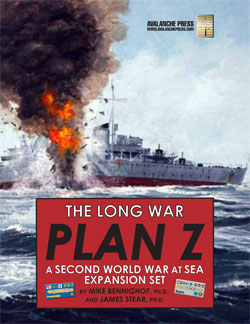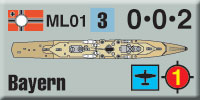Plan Z:
Modern Minelayers
by Mike Bennighof, Ph.D.
November 2021
 The German Kriegsmarine entered the Second World War with a decided lack of purpose-built minelaying vessels. The old Imperial Navy had learned the necessity of mine warfare during the First World War, and operated a quartet of mine-laying cruisers (two old and two new) but otherwise depended on other warships and converted merchant ships pressed into mine-laying duty. The German Kriegsmarine entered the Second World War with a decided lack of purpose-built minelaying vessels. The old Imperial Navy had learned the necessity of mine warfare during the First World War, and operated a quartet of mine-laying cruisers (two old and two new) but otherwise depended on other warships and converted merchant ships pressed into mine-laying duty.
The Kriegsmarine did the same. Destroyers, torpedo boats and cruisers dropped mines along with minesweepers, motor torpedo boats, submarines, gunnery training ships and an array of impressed civilian vessels ranging from fishing smacks to auto ferries and small passenger liners. Captured Dutch, French and Norwegian minelayers also came into service, but no purpose-built German vessels.
Germany laid tens of thousands of mines, but did so in a very inefficient fashion. The warships in particular represented a great operational expense considering the relatively small number of mines they could carry, and their deployment on minelaying missions left them unavailable for other needed tasks. German planners realized this shortcoming before war broke out, and tried to take steps to remedy it.
Spain had just completed the four minelayers of the Jupiter class, modern ships displacing 2,100 tons and carrying a destroyer’s gunnery armament plus 264 mines. They were very slow (18 knots) which dismayed the Germans, but served well as gunboats and escorts during the Spanish Civil War. Despite receiving massive German aid, the Franco regime refused to part with its minelayers without payment in gold and the Germans had to look elsewhere.
 Without the hard currency to buy ships from Spain or other sources, the Germans had to look to their own shipyards. And so the Kriegsmarine’s Plan Z included new mine warfare vessels – under the budgetary bounty of Plan Z, every constituency within the Navy got its wish list granted. The new design would be a fast mine-laying cruiser, capable of offensive operations in the North Sea and the Baltic, and possibly beyond. Without the hard currency to buy ships from Spain or other sources, the Germans had to look to their own shipyards. And so the Kriegsmarine’s Plan Z included new mine warfare vessels – under the budgetary bounty of Plan Z, every constituency within the Navy got its wish list granted. The new design would be a fast mine-laying cruiser, capable of offensive operations in the North Sea and the Baltic, and possibly beyond.
Conceptually, the new ships drew their inspiration from the fast mine-laying cruiser Bremse of the First World War. Bremse had a fairly high speed (28 knots) and good radius of action, and could carry 400 mines. She and her sister were considered very successful ships, but completed only a handful of actual minelaying operations. Both would be scuttled at Scapa Flow in 1919.
The new mine-laying cruiser, described as an “offensive minelayer” rather than a cruiser, would displace 5,700 tons, larger than the old Bremse, and make the same top speed (28 knots) and carry the same mine load (400). The design would be an enlarged and much faster version of the gunnery training ship Brummer commissioned in 1936, and also appears to have drawn heavily on the British minelaying cruiser Adventure, commissioned in 1926.
Like Brummer, the new ship (with the prosaic project name of Minelayer A) had a transom stern to help improve her speed, but a much larger after deck that covered the mine rails and mines. The British had used the same approach in Adventure, and found that the “dead water” this caused directly aft of the ship increased her speed but also tended to suck the mines dropped from her rails back into the hull. A lightly armored deck (20mm thick) covered the mine-handling area. Most of the size increase came from the demands for high speed and, like all ships of Plan Z, long range. To make her 28 knots, Minelayer A would have four high-pressure boilers powering two turbines for 40,000 horsepower. She would have had more range than she probably needed, but not enough to operate as a long-range threat to enemy commerce.

The second minelayer Brummer (a captured Norwegian vessel) shows off her transom stern and mine doors, similar to Minelayer A’s original design.
The new ship carried the same armament as Brummer: four dual mounts for 105mm (4.1-inch) anti-aircraft guns, plus a smattering of light guns. With her high superstructure and her mine load, she would have been seriously top-heavy with anything heavier. Despite her size, she carried only 400 mines, the same as Brummer (and Adventure, which was a slightly bigger ship than the German design but had a similarly large power plant).
In sharp contrast to the glamorous battleships and carriers of Plan Z, the minelayer actually filled a pressing need for the Kriegsmarine and the Warship Construction Office presented a reasonable design (apart from the mine-attracting transom stern). Therefore, following the twisted logic of Erich Raeder’s Kriegsmarine, the project received low priority.
Two ships were ordered in the summer of 1938 from Deschimag, but neither had been laid down when war broke out a year later. Six more were ordered in 1939: two of them to the fast minelayer design, two fitted as gunnery training ships and two as cadet training ships. In an unusually practical measure (by Kriegsmarine standards) the four training ships were built to be quickly modified to lay mines in the event of war. The two gunnery training ships could only carry 320 mines as opposed to 400, and had a slightly different main armament with four 127mm (4.7-inch) guns in four single mounts in place of the dual 105mm positions.
The order for training ships reflects another aspect of Plan Z often ignored both by German planners at the time and writers in the decades since: where did the Germans expect to find trained crews for this huge number of huge new warships? The six battleships of the H class alone would have required 15,000 men, almost all of them highly-trained specialists, plus thousands more support personnel. Those men could not have been provided without a massive increase the Kriegsmarine’s training establishment.
All eight of the contracts would be cancelled soon after the invasion of Poland. The Kriegsmarine impressed a number of civilian ships to lay mines, and these did the bulk of the work. The German Air Force, ever eager to expand its mission brief, also took over a good amount of mine-laying work, dropping the weapons from aircraft. Plans to use destroyers and cruisers as minelayers ran afoul of the poor reliability of their overly-sophisticated power plants. Their operational readiness remained low throughout the war, and commanders proved reluctant to expend their rare availability on such mundane missions as mine-laying.
Plan Z was always a fantasy proposal, though it’s likely that Navy commander Admiral Erich Raeder believed that its powerful new fleet could actually be built. It’s clear that others within the Navy’s hierarchy, particularly the Warship Construction Office, doubted that the big warships would ever see action. Unlike some nations’ fantasy proposals, Plan Z at least made a nod (though not a particularly realistic one) toward expanding the Navy’s infrastructure and building the necessary auxiliary vessels to support the fleet.
We included all eight ships in Second World War at Sea: Plan Z, all of them in minelayer configuration.
Click here to order Second World War at Sea: Plan Z (book edition) right now.
Sign up for our newsletter right here. Your info will never be sold or transferred; we'll just use it to update you on new games and new offers.
Mike Bennighof is president of Avalanche Press and holds a doctorate in history from Emory University. A Fulbright Scholar and NASA Journalist in Space finalist, he has a whole passel of books, games and articles on historical subjects.
He lives in Birmingham, Alabama with his wife, three children and his dog, Leopold.
Want to keep Daily Content free of third-party ads? You can send us some love (and cash) through this link right here.
|
